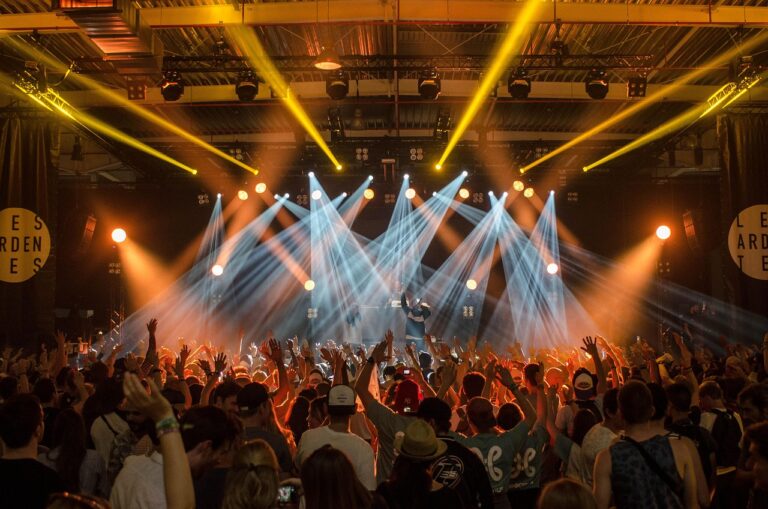Curious about salary expectations for an entry-level stage technician in NYC? Here are the hard numbers people actually quote: small theaters advertise $18–$25 per hour, corporate AV entry calls land roughly $22–$30 per hour (or $225–$350 per day), and Broadway-adjacent overhire gigs can jump into the mid-$30s to low-$40s per hour—often higher with contract overtime. Your weekly take-home will swing with call length, overtime, and whether you’re on a W-2 or 1099.
If your goal is a grounded expectation: a realistic starting gross in the first year runs $32,000–$55,000 with mostly nonunion hours, and $50,000–$75,000 if you land consistent higher-rate calls and overtime. Below are the drivers, trade-offs, and precise scenarios so you can benchmark offers and plan a path upward.
What Starting Pay Looks Like Now
Small and midsize theaters (off-off and many off-Broadway shops) commonly post $18–$25 per hour for run crew, load-ins, and strikes. Minimum calls are often four hours, and overtime is after 40 hours in a week. Some houses bump to $26–$30 for show-call audio or board ops, particularly if you’re trusted to troubleshoot on the fly.
Corporate AV (hotel ballrooms, conferences, galas) tends to pay better at entry level: $22–$30 per hour W-2, or a day rate around $225–$350 for 8–10 hours. Night resets, room turns, and strike-heavy schedules can add overtime. Larger AV companies may offer health insurance after a probationary period; freelance day rates are higher but carry no benefits and unpaid downtime between gigs.
Broadway and major touring load-ins are usually under union contracts (e.g., IATSE Local 1 in NYC). Entry overhire calls for general stagehands, electrics, or audio utility can land in the mid-$30s to low-$40s per hour, with premiums that increase total pay: time-and-a-half after a set threshold (often after 8 hours) and doubles late at night or on 6th/7th consecutive days, depending on the contract. Getting onto these calls typically requires referrals, experience, and good reputation for safety and pace.
College venues, festivals, and museums fall in between: $20–$30 per hour is common. Some institutions have predictable schedules and W-2 stability but fewer overtime spikes; festivals can compress 50+ hours into a week, which pushes gross pay up but is seasonal and physically demanding.
New York State Department of Labor: Overtime is 1.5x after 40 hours in a week; NYC minimum wage is about $16/hour as of 2024.
Factors That Move Your Rate
Union status and venue scale matter most. Nonunion storefront theaters pay near the low end. Corporate AV and broadcast-adjacent venues pay mid-range with steadier calls. Unionized productions pay more per hour and layer on premiums (overtime, meal penalties, turnaround) but have higher entry friction and expectations for speed, safety, and discipline.
Specialized tasks raise rates: comfortable RF coordination, mixing smaller bands, console familiarity (QL/CL, SQ/Avantis, or Profile/S6L), moving-light troubleshooting, basic Vectorworks/Lightwright literacy, or safe chain motor support. Even at entry level, a scissor-lift card, OSHA-10, and demonstrated cable management and patching can be the difference between $22 and $28 per hour on corporate calls.
Schedule premiums are real. Overnight changeovers, 12+ hour show days, and “show plus strike” calls usually escalate pay via overtime and penalties. Holidays and 6th/7th consecutive day work are often paid at time-and-a-half or double-time (contract-dependent). Off-hours travel, split shifts, and short turnarounds should be clarified in writing to ensure compensation.
Engagement type affects your net. W-2 roles with a hotel AV company might pay slightly less per hour but add benefits (healthcare, PTO, employer FICA, sometimes overtime compliance without negotiation). 1099 gigs offer higher face rates but require you to budget 15.3% self-employment tax, buy your own insurance, and absorb unpaid prep time, commute, and cancellations unless you set terms.
Annual Income: Three Realistic First-Year Scenarios
Theater-heavy entry path: Assume 30 hours/week across two small venues at $22/hour during active runs, with 10 weeks of downtime or underemployment sprinkled through the year. Gross during active weeks: $660. Active weeks (42): $27,720. Add occasional load-in/strike overtime bumps (+$2,500) and a few $250 day-rate festival days (+$1,000). Result: roughly $31,000–$34,000 gross. After payroll taxes and NYC costs, expect roughly $2,000–$2,400 per month in hand during active periods, dropping in downtime unless you backfill with temp work.
Corporate AV mixed schedule: Assume 40 hours/week at $26/hour for 30 weeks, plus 12 weeks at 20 hours/week, plus six 10-hour day-rate gigs at $300. Core gross: 30×(40×26) = $31,200; lighter weeks: 12×(20×26) = $6,240; day-rate gigs: 6×300 = $1,800. Total around $39,000. Add typical overtime bursts during conference season (+$3,000–$5,000) and you’re at $42,000–$44,000. If you go 1099 for some gigs, set aside ~25–30% for taxes to be safe; effective take-home after tax and basic expenses may feel similar to a $38,000 W-2 with benefits.
Union overhire momentum year: Suppose you secure periodic Broadway load-ins at $38/hour with regular overtime. Five weeks per year at 55 hours/week: base 5×(40×38) = $7,600; overtime 5×(15×57) ≈ $4,275 (assuming 1.5x = $57/hour); total ≈ $11,875 from those weeks. Add 30 weeks of corporate AV at $27/hour, 35 hours/week: ≈ $28,350. Add 10 festival days at $325: $3,250. Aggregate ≈ $43,000–$47,000, with upside if you catch additional overhire or 6th/7th day premiums. Volatility risk: cancellations and uneven scheduling can lop 10–20% off if you can’t fill gaps quickly.
Cost-of-living check: a shared room in the outer boroughs often runs $900–$1,400/month; studios commonly exceed $2,300. A 30-day transit pass is roughly $132. Groceries for one person: around $350–$500/month. Without employer health insurance, individual marketplace premiums can range ~$250–$500/month for basic plans. At $40,000 gross with standard withholdings, cash flow covers basics if hours stay consistent; gaps between gigs are what damage savings, so build a one- to two-month expense buffer early.
Negotiating Smart As A New Tech
Set a floor and a framework, not just a number. For W-2 hourly roles, a defensible entry ask is $24–$28 for general crew in corporate AV and $21–$25 in small theater; justify with specific tools you can run (consoles, comms, RF coordination, basic lighting patch). For 1099 day rates, start at $275–$325 for an 8–10 hour local call when you’re shouldering your own insurance and gear. If a client offers less, trade scope: reduce hours, limit responsibilities, or ask for an assistant.
Clarify overtime triggers, minimum call, and cancellation terms in writing. Common minimums are 4-hour calls; corporate half-days are often billed at 5 hours. Ask how overtime is calculated (after 8 hours/day or only after 40/week). Establish a 24–48 hour cancellation window with a partial fee if the gig evaporates. Confirm travel, load-in/load-out coverage, and whether meal breaks are on the clock or off.
Monetize small skill stacks. Examples: add $2–$4/hour for reliable RF mic deployment and frequency coordination on 8–16 channels; command higher day rates if you can mix a simple music act while handling emcee mics; ask for a bump for projection mapping or switching on ATEM/Barco with basic showfiles. Bring PPE, labelers, a clean tool kit, and know basic signal flow—this gets you rehired at higher rates more than anything else in year one.
Build pipeline and proof. Maintain a calendar visible to trusted leads, accept last-minute calls when feasible, and follow up after clean shows with a short note listing what you handled (“A2 for 12 wireless, patched decks, operated Clear-Com, broke down backline”). Three to five dependable point-of-contact relationships typically fill a new tech’s schedule faster than spraying résumés into applicant portals.
Mechanics, Risks, And Practical Constraints
Hours are spiky. Expect weeks at 15 hours and others at 60. Protect sleep and safety: fatigue leads to mistakes that damage gear and reputations. Learn how to clock out of unsafe situations (e.g., lack of fall protection, rushed rigging) and escalate concerns early; reputable leads will listen, and you preserve employability.
Certifications help but don’t replace references. OSHA-10 is a low-cost credibility booster. Aerial/scissor-lift training is often requested for arena and ballroom work. ETCP is not entry-level but shadowing riggers and learning ground-rig math increases your value quickly. Fire watch or crowd management certifications can unlock venue-specific call lists.
Track true hourly value. Include unpaid commute, pickup/drop, and pre-show prep in your mental math. A $300 day rate that consumes 14 total hours door-to-door nets less than $26/hour pre-tax. When two offers conflict, choose the one that builds repeatable skills, referrals, and higher overtime potential—even if the headline rate is slightly lower.
Budget for gear and downtime. Expect $150–$300 for basic PPE and small tools to start, then pace purchases (good headlamp, multitool, gloves, tape, headphones). Save 10–15% of each check for slow weeks. If you’re 1099, reserve an additional 15–20% for taxes in a separate account.
Conclusion
For year one in NYC, anchor your expectations at $22–$30/hour for most nonunion calls, $225–$350 day rates for corporate work, and mid-$30s to low-$40s/hour on union overhire when you can get it. Stack safety and console skills, clarify overtime and minimums in writing, and cultivate a handful of reliable leads. Use volatility-aware budgeting and choose gigs that compound skills and referrals; that’s how entry pay turns into predictable, higher-rate work within 6–12 months.



